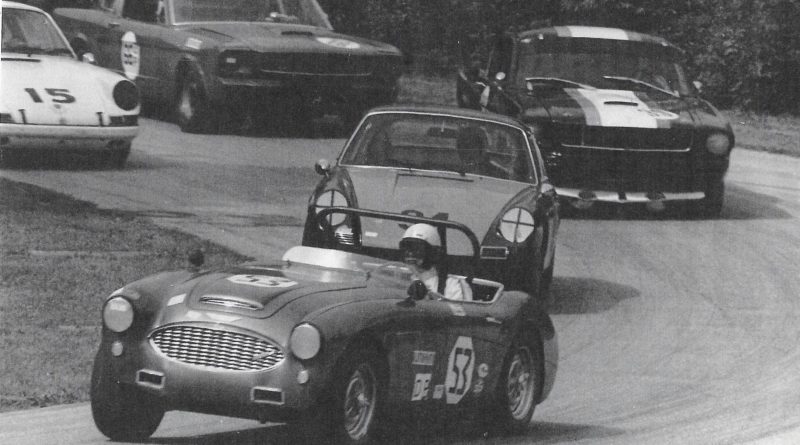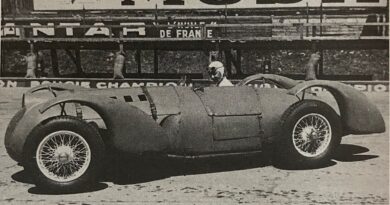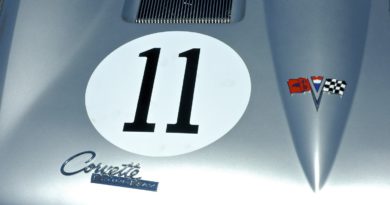Serendipity yields car nirvana
Above photo: Geoff Tedder drives his Austin Healey 3000 in the 1970 SCCA June Sprints at Road America, Elkhart Lake, WI
It’s funny how things evolve. By keeping up with my car club I happened upon Nick Candee, an authoritative car historian and former editor of the Aston Martin Owners Club magazine, Vantage Point. Janice and I were at an AMOC-sponsored Pebble Beach party in August of 2017 and struck up a conversation with Nick. In among the usual car-related conversations, he lamented that although he had a driver slot in the upcoming La Carrera PanAmericana race through Mexico, he didn’t particularly feel physically up to the challenge. And with that, he casually turned to me and offered his seat, if I was interested. Well, I didn’t hear much of the conversation after that, preoccupied with wondering if this man was serious. I later brought the subject up again, saying I was definitely interested and asking what would be involved. He gave me his card and I promised to follow up with him, which I did a few days later.
True to his word, Nick connected me with the team owner, Clyde Morter, in Elkhart Lake, WI. Elkhart is the location of the famous Road America racetrack. Clyde had raced the La Carrera PanAmericana several times. He graciously invited me to the Road America Vintage Races taking place in mid-September, and offered me the chance to drive the PanAmericana car they would be using in the 2018 race. Only vintage vehicles up to about 1975 are eligible and older American cars are a popular choice. His was a race-prepared 1954 Oldsmobile with modern engine, brakes and mechanicals. These cars often ended up much like vintage NASCAR stock cars in that the bodies and frames were about the only things left untouched. I couldn’t wait to both drive at Road America and try the car.
The La Carrera PanAmericana race originated in 1950 and was an annual event until 1954. Meant to model Italy’s Mille Miglia and the Targa Florio rallies, it was cancelled because it had both attained its goal of advertising the Pan America Highway through Mexico and infamously gained a reputation as the world’s most grueling and dangerous race. It had attracted top drivers from all over the world, but the death toll averaged six people a year. The race was revived in 1988 and still tours over some of the original course during its 2,000 mile, 7-day running. I had read about the race and watched a few documentaries. It looked as if a good goal would be to simply finish and not get too carried away with a competitive spirit if one wanted to survive. That sounded like my kind of goal setting. It would be interesting to see if Clyde shared my thoughts. This was supposed to be a challenge, but mostly it was supposed to be fun, not life-threatening.
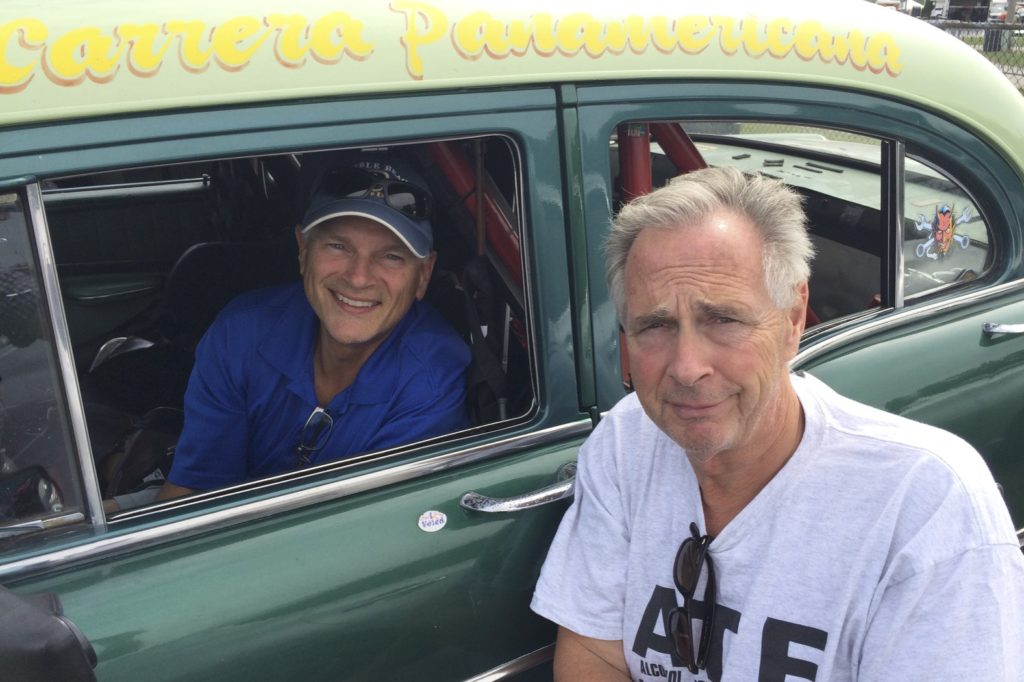
I spent the weekend of September 15 with Clyde and a couple of his old buddies, Geoff Tedder and Bill Halvorson. Clyde was 67, Geoff and Bill were 77. At 64 I was the youngster. Geoff had done a bit of racing in his time, so it was fun to chat with them about cars and racing. Clyde was an excellent host, and it became evident he was recruiting me as much as I was trying to show myself qualified to partner with him in next year’s PanAmericana race. He put me up in his own home and wouldn’t allow me to pay for anything. I drove the ’54 Olds on some back roads on Saturday morning to get used to its idiosyncrasies, and it did have a few. For starters, the steering wheel was awkwardly positioned, something like driving a bus – high and a bit flat, not at all to my liking. Second, the steering was a bit loose as if it needed a new gearbox and the turning ratio was too high, requiring too much action to get through tighter corners. Lastly, the brakes were high performance discs with pads intended for constant, hard, high speed braking – not the kind of driving we would be doing in a Mexican open road race. Racing brake pads have almost no stopping power until they get hot, and there was simply not enough of that kind of braking required for the PanAmericana. He admitted to both those issues and said they were going to address them, which made me feel much better. Later that evening at a Concours event at the famous Seibken’s Resort in Elkhart Lake called “Show on the Greens,” I met Clyde’s brother and mechanic, Guy. Guy was an experienced race prep and restoration mechanic, so he knew his stuff. All this gave me what I needed to see of their operation.
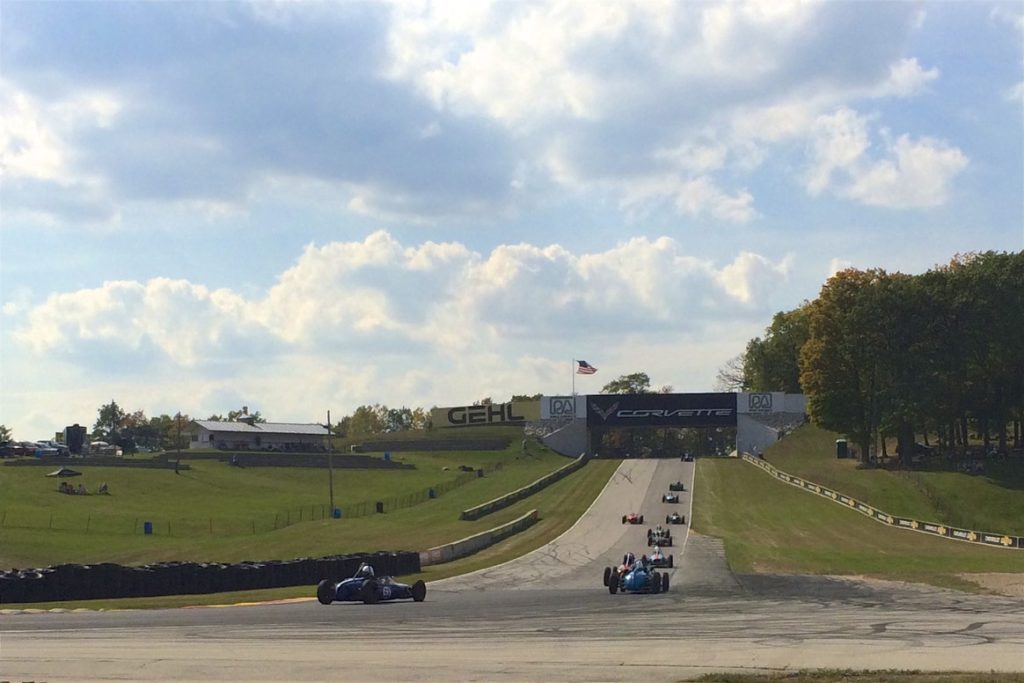
Geoff was revisiting Road America for the first time in 47 years after experiencing a particularly scary accident there in 1970. He was driving in an SCCA mixed production class race with his Austin-Healey. The Road America course has a relatively high-speed 180º carrousel followed by a series of high-speed esses. At the exit from the carrousel a Corvette had blown its engine, spewing oil all over the track. A 13-car pile up ensued with Geoff getting some of the worst of it after spinning, being hit and ultimately flipping three times before somehow coming to rest right side up. Healey’s are open cockpit cars and only the roll bar and a good bit of luck saved him and his exposed noggin from serious injury. Somehow he walked away and although he was pretty sore, still danced a bit at a post-race party later that night!
At Sunday’s testing of the ’54 Olds, Geoff brought along his camera and took laps with me, I think as much to commemorate his accident as to relive the experience of driving the track. We took it relatively easy, probably topping out at about 120 MPH. It’s a bit of a guess because the speedometer was not connected, so I only had a tachometer to go by. A tach is far more important to a racer than a speedometer anyway, so that was fine. Other than the awkward orientation of the steering wheel and the lack of warm brakes, the car handled predictably with plenty of suspension travel that would be needed on open Mexican roads. The Olds was actually quite civil, and Geoff complimented my driving as I became more comfortable with pushing the car and hitting the right lines.
The track itself is legendary, universally recognized as one of the finest in North America. It is technical and varied with a fine running rhythm and good safety features such as wide bailout areas and substantial sand runouts to slow cars going off track. The grounds are immaculate, with good views of the track, scenic groves of trees and well-groomed grass everywhere. Extensive camping and paddock areas and complete amenities make it a great facility. Road America was built on a gravel pit and opened in 1955 after the Elkhart Lake Road Races were deemed too dangerous to continue in 1952. The inaugural 1950 race garnered 33 entrants and 5,000 fans to watch novice and experienced drivers in five events over a 3.4-mile circuit. In 1951, the circuit was expanded to encompass the Lake, measuring 6.5 miles and attracting a few high-powered professionals. John Fitch, driving a Cunningham CR2 roadster, claimed victory in the 30-lap feature race, one of only two that year. Still, it attracted 50,000 spectators. In 1952, 238 entries and over 100,000 people witnessed future Formula One world champion Phil Hill win the Saturday race in a C-type Jaguar and John Fitch, this time in a Cunningham C4R, win the Sunday main event. Cunningham’s were American cars designed and financed by Briggs Cunningham, and raced with some success at LeMans.
Open road racing in America was becoming a huge event in the early ‘50s. Other open road races across the country at Watkins Glen, Pebble Beach and Daytona were also being enthusiastically supported. The inherent danger of these events along with a few deaths motivated local municipalities to ban them. This led immediately to the building of several race tracks in the mid-‘50s that still exist today, including Road America, Daytona, Watkins Glen, Sebring and Laguna Seca. So, here I was experiencing another item on my bucket list, one that four weeks ago was nowhere near the top of the to-do list. In addition, I was also now in a position to drive in one of the world’s greatest open road races, and truly the only one still competitively raced, the following year. Serendipity like that simply can’t be predicted. But involving one’s self in events where like-minded people with the means, resources, and connections congregated inevitably creates opportunities to explore new horizons. And that was exactly what attending Monterey Car Week in 2017 did for me. Adventure and opportunity, no matter the scale, always awaits those seeking it.

